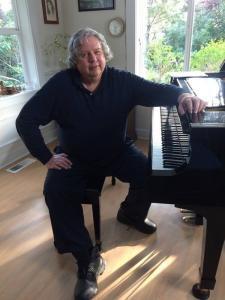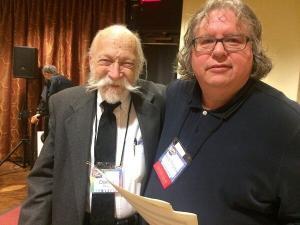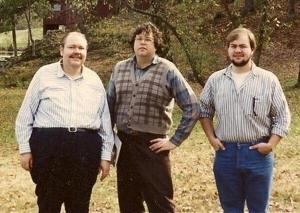 Those who have been moved by the lyrically sensitive compositions of David Thomas Roberts and have found them to stimulate mind and soul will understand the delight I recently felt visiting with the composer. This gentleman of many aptitudes was kind enough to generously engage in a series of lengthy telephone conversations with me recently. He was graciously warm and considerate of my musical illiteracies. The conversation was as invigorating as I find his music to be.
Those who have been moved by the lyrically sensitive compositions of David Thomas Roberts and have found them to stimulate mind and soul will understand the delight I recently felt visiting with the composer. This gentleman of many aptitudes was kind enough to generously engage in a series of lengthy telephone conversations with me recently. He was graciously warm and considerate of my musical illiteracies. The conversation was as invigorating as I find his music to be.
We discussed so much, and I regret that there is room to share only a few of the elements we covered along with a summation of his musical creativity. To write about the career of David Thomas Roberts is to undertake a challenging but delightful task. It is challenging because the composer is deeply introspective with a soulfully complex mind. It is difficult to extract and discuss one aspect of his artistic achievements without referencing his other endeavors and interests. He is an accomplished author, poet, visual artist, composer, and pianist.
As a composer he was very descriptive when talking about the influences on his life and especially on his music. I will avoid referring to his early years in Kreole, Mississippi, as humble beginnings, for as I listened to him describe his early life in great detail, I came to realize how much he derived from his childhood. While his family was far from financially well-off in the late 1950s and early 1960s, the experiences that led him to pursue and develop all of his talents, were rich enough to form a sound base for his life and career. It is difficult to describe and explain any one of his talents without considering them all together.
Roots
Roberts was born in 1955 and recalls, “From my earliest childhood, I lived much in my imagination. I was an only child until I was eight and my world consisted of what I imagined, and what I found in books. Books were important to me before I went to school,” he explained, “and there was what came in over television in the late 1950s and early 1960s to feed me the darker aspects of life. I lived a life of singularity, with an ever-imagining mind, from an early age.”
His family’s 10 x 50 foot trailer was too small for a piano but his parents gave him at least two toy facsimiles. “They did the best they could with the obsession I had…to live within musical expression,” he recalled. He also began drawing when he was four. The family’s move to a house in 1962 meant there was space for a piano and, “by the age of eight, I was trying to do all the things I do now,” he reflected.
“I didn’t have parental restraints, [rather] encouragement in fact,” he said, though “later I came into conflict with my parents as artists often do. I wasn’t going to make it easy by getting a job or trying to get along with people…which was a chafing, alienating thing [leading] to a lot of trouble.”
David spoke fondly of a first-grade teacher, Ms. Virginia Eselin, who became his champion. He began taking piano lessons from Amelia Cook in Moss Point, and played his first composition, a waltz, at a recital in 1963. However, after two years of piano lessons, he left his teacher. At age eight, he began teaching himself visual art. “By the age of thirteen, I was forging into territory that would predict my mature style as a visual artist…It is important to note that I was and remain entirely self-taught,” he emphasized.
During our conversation, Roberts spoke of the early musical influences on his development around the age of fourteen. “I worked with rock music…and always had a relationship with popular music. “My ragtime [compositions] would not be the same…without the impact of Rock and Roll and especially the more lyrical dimensions of the rock voice,” Roberts explained.
When he was fourteen, Roberts discovered Rachmaninoff’s Piano Concerto No. 2. Whereas Chopin led him at age eight to “discover the broader, ambitious spectrum of serious, unbridled music making, the Rachmaninoff work brought me back to the idea of equipping myself to become a composer.” At that time, Roberts studied with another local teacher, Theresa Santarelli, from whom he learned a great deal. After about three years, he again went his own way.
At eighteen, Roberts entered the University of Southern Mississippi to study theory and composition. Ragtime works such as For Teresa and The Hattiesburg Winter Waltz date from this period. After transferring to Florida State University in 1976, he became disillusioned with academia, finding it “an impediment to serious work,” and left to begin performing in New Orleans in earlier 1977.
Finding Ragtime
Many influences, from Romanticism to early rock ’n’ roll to various ethnic music “co-mingled” to inspire his original compositions. However, “Frederic Chopin has been the most potent musical force in my life…his expression is foundational to my relationship to the ideal practice of becoming a composer.” Other important influences were Brahms, Schumann, Charles Ives, Erik Satie, and John Cage.
Roberts related in vivid detail, how he discovered Scott Joplin’s work on Joshua Rifkin’s first Nonesuch Album. “After I heard Maple Leaf Rag, which opens side one, and above all Gladiolus, which closes the side, my life was never the same again. You talk about recovering some great, endlessly meaningful, self-revealing piece of lostness! [Joplin’s music] now made everything come together…in my psyche. That is exactly how I became a ragtime composer.”
Works

The compositions of David Thomas Roberts are a beautiful aspect of his total artistry and if his work is not well-known to TST readers, I certainly encourage an immediate acquaintance. In his long career he has written over 150 musical compositions, and over 40 have been commissions. He points out that commission payments are a vital part of his income. His commissioned work includes pieces dedicated to people, places, and events. Victorian Gardens, written for Arlo “Chip” Lusby and commissioned by Danny Matson is one of David’s more recent.
Roberts has been recording since 1978. After two early albums featuring the compositions of others, Pinelands Memoir and Other Rags (Euphonic, 1983) entirely featured his original work. The album contained one of his most popular pieces, “Roberto Clemente,” named for the humanitarian baseball Hall-of-Famer killed in a plane crash taking supplies to earthquake victims in Nicaragua in 1972. 1983 also saw the release of Through the Bottomlands (Stomp Off, 1983), the title track of which would become another of Roberts’ most appreciated works. Many of Roberts’ earlier compositions remain standards in ragtime performance repertoire.
Roberts’ long, complicated and intimate association with New Orleans found expression in his magnum opus of the 1980s and longest completed work to date, the 15-section suite, New Orleans Streets. With the release of the CD, New Orleans Streets 1981-1985: Suite for Piano (Solo Art, 1992,) listeners could experience Roberts’ eclectic range of musical blendings and penchant for drama on a grand scale. As the composer says, “New Orleans Streets is a testament of affection for my most accessible and, in some cases, formative influences. Romanticism, early jazz, ragtime, early rock ’n’ roll/rhythm and blues, Latin genres, Mediterranean music, hymns, and country music all have their say in its identity. It is also a series of reflections upon my urban life as a young man, a farewell to my 20s amid Greek Revival architecture, an adventure in certain poignant extremities of human experience. Its specific ancestors range from the Chopin nocturnes to Ferd Morton’s habaneras to Lloyd Price songs, to Mussorgsky’s Pictures at an Exhibition and Albeniz’ glorious Iberia, all of which feed the vulnerable, confessionally narrative tone and intention of the work.”
American Landscapes (Pinelands, 1995) contains compositions from the composer’s rural, midwestern, and southern experience with some baseball themes included. Like several of the other tracks, “Last Days of the Polo Grounds” is a memory arousing piece that is sadly comforting for me. American Landscapes is the album with many of my personal favorites, and the last track, “For Kansas City,” reminds me of my home there. Roberts’ album Folk Ragtime 1899-1914 (Stomp Off, 1998) includes a representative selection of early twentieth century folk ragtime compositions.
Roberts has also recorded the homespun folk ragtime of Brunson Campbell, the white lad from Kansas who sought out Scott Joplin in Sedalia in the 1890s. Roberts had been intrigued by Campbell’s idiosyncratic compositions and infectious performance style since 1978, and in the album titled The Collected Brun Campbell (PianoMania, 2000), he endeavored to play Campbell’s pieces as Joplin’s disciple had preserved them in commercial releases and home recordings between 1945 and 1949. Also included was Campbell’s stylized version of “Maple Leaf Rag”, which Brun said he had learned from Joplin in 1898. Roberts’ disc is a valuable historic record of Brun Campbell’s composing and a tribute to an important personality from the days of ragtime’s infancy.
In the new century, Roberts has also issued Volume 1 of his recordings of The Complete Piano Music of Scott Joplin (Solo Art, 2003) that includes 14 Joplin compositions. He has also collaborated on numerous albums, including Frontiers (Pianomania, 1994) and Terra Verde (Viridiana, 1996,) with Scott Kirby and Frank French. Early Tangos to New Ragtime (PianoMania, 1995) is an eclectic look at the range of New World piano, important to Roberts. Discovery (David Thomas Roberts Music, 2005) is an ambitious presentation of a variety of Roberts’ work, with an emphasis on his Neoromantic side. In addition to ten of Roberts’ compositions, it includes pieces by Harold Budd and Scott Kirby.
Roberts coined the term “Terra Verde” (Green Earth) to designate a style of composition that has evolved in part out of ragtime and owes much of its identity to Romanticism and various New World styles. The music seems to celebrate the connection between people and the land on which they live, a theme that runs through much of the composer’s work.
In addition to his own LPs and CDs, David has contributed recordings for five albums of collected works including Diamond Cuts (Hungry for Music, 1998), an album made to raise money to help inspire disadvantaged people, by offering them exceptional musical experiences.
Ever an Artist
While I have focused primarily on David’s ragtime and ragtime-influenced work in this article, I should also mention that he is a versatile composer and has also written chamber music, choral pieces, art songs, electronic works, and organ music.
David Thomas Roberts continues to perform, compose and record. One project he is particularly eager to launch is a landmark recording, to be produced by Bryan Wright of Rivermont Records. Roberts and Wright have recently announced the upcoming release of a multi-disc set of folk rags, “a quasi-encyclopedic collection like no other,” according to Roberts. It will be the culmination of a dream the composer has had since the 1980s. Roberts is currently previewing the collection in concert, with example programs featuring works by Calvin Lee Woolsey, Charles Hunter, E. Phillip Severin, Edgar “Jelly” Settle, Clarence H. St. John, Tom Shea, Trebor Tichenor, Thomas Broady, Callis Welborn Jackson, J. M. Wilcockson, and Roberts himself. Many more composers will also be included on the Rivermont release.
Raising funds for production of the massive folk rag CD set will be challenging, but both Roberts and Wright anticipate a large financial response when the appeal is made.
Now in his fifth decade as a working multimedia artist, Roberts is envisioning the establishment of a physical archive space that will preserve all of his creative endeavors: his visual art, poetry and other writings, and of course his recorded performances and musical compositions. His vision is that crucial support will emerge to assist with the realization of this goal.
 Many of David’s devoted followers esteem his visual art. His work is often referred to as Outsider Art, Visionary Art, and Imagism, and has been featured in the preeminent magazine of Outsider expression, Raw Vision. His art often appears in gallery shows and has been displayed in well-known museums and institutional settings. His paintings and mixed-media drawings frequently provide covers for his recordings and sheet music.
Many of David’s devoted followers esteem his visual art. His work is often referred to as Outsider Art, Visionary Art, and Imagism, and has been featured in the preeminent magazine of Outsider expression, Raw Vision. His art often appears in gallery shows and has been displayed in well-known museums and institutional settings. His paintings and mixed-media drawings frequently provide covers for his recordings and sheet music.
Much has been written about the creative genius of David Thomas Roberts. Trebor Jay Tichenor, the legendary performer, collector extraordinaire, and composer of Mississippi Valley rags referred to Roberts as “our foremost composer of contemporary ragtime.” David has written fondly of visiting Tichenor in his St. Louis home “where I have never been more welcomed…and which I will always remember as a beloved home.”
Al Rose, New Orleans Jazz authority and commentator wrote in 1986, “David Thomas Roberts is the most important composer of this half-century in America.”
His music has always possessed a liltingly elegant, transcendent quality and he evokes a range of emotion from the hauntingly and often sadly sentimental to the joyously sensual.
As a young composer, David wrote that in early childhood he “felt akin to those in encyclopedias, and believed I would someday enter them myself.” Unlike Scott Joplin, he has already achieved considerable eminence in his productive lifetime, and I for one await the fulfillment of his archive goal that will finally array all of his achievements to be experienced as elements of the whole of his life’s work.
For more information about David or to get in touch with him, visit his website at www.davidthomasroberts.com.
Larry Melton was a founder of the Scott Joplin Ragtime Festival in 1974 and the Sedalia Ragtime Archive in 1976. He was a Sedalia Chamber of Commerce manager before moving on to Union, Missouri where he is currently helping to conserve the Ragtime collection of the Sedalia Heritage Foundation. Write him at lcmelton67@gmail.com.






















